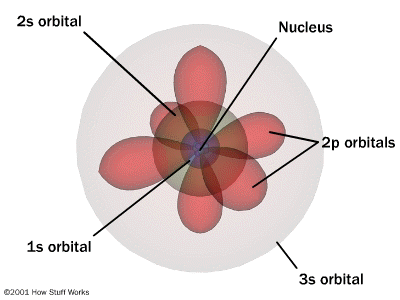Atoms and Apples
What’s Real
 The real world is the world we directly perceive. It is all we immediately see, hear, feel, smell, and taste, (called perception) including all direct perception of our own bodies and their internal states, (called interoception).
The real world is the world we directly perceive. It is all we immediately see, hear, feel, smell, and taste, (called perception) including all direct perception of our own bodies and their internal states, (called interoception).
Reality includes all that we directly perceive, as well as, all that we can perceive indirectly, by means of devices and instruments, such telescopes, microscopes and various electronic detectors, and most importantly, it includes the fact of our perception of that real world.
It is that real world and our perception of it that all knowledge is knowledge of and about. All knowledge begins with our perception, (consciousness awareness), of that reality and the fact that we are conscious of it.
The reality we are concscious of and our consciousness of it are all there is. Nothing can exist that cannot be discovered by means of that which can be directly perceived. There can be nothing for which there is no perceiveable evidence whatsoever, or cannot be discovered by means of reason from what can be directly perceived.
While every aspect of reality cannot be directly percieved, there can be no aspect of reality that cannot be discovered by means of those aspects (attributes, characteristics, properties, or qualities) that can be directly perceived. All perceiveable aspects of reality are exactly as they are perceived.
Denials Of Reality
Views that deny reality and its nature have dominated the entire history of intellectual enquiry. With few exceptions, every philosopher and all ideologies have contrived to repudiate the validity of perception and the reality of the world we live in and direcly consciously experience. The majority of mankind embraces some form of denial of reality. I’ve explained elsewhere why reality is hated and why what most of humanity believes is not true.
Are Atoms Real?
While some denials of reality as perceived simply deny that reality exists at all or can be perceied or known as it actually is, most such denials resort to assuming some, “transcendent,” “supernatural,” or other, “mystical,” form of existence one cannot be directly conscious of, or conscious of at all. The modern day exception to that denial, is one that is supposed to be, “scientific.”
One modern denial of the reality of directly perceived existence is the assertion by some scientists, (and many philosophers who understand nothing about science), that perceived things, like apples, are not real, or not, “as real,“as that existence described by the sciences of chemistry and physics. The argument is that everything is made of chemical atoms and sub-atomic particles which are the, “really real elements,” of existence while perceived existents (like apples) are only configurations of chemical elements (atoms), of which all physical entities are composed.
Since the physical entities that are directly perceived are nothing like the atoms of which they are composed, perceived physical entities, and their properties, it is claimed, are therefore just impressions or illusions produced by how the configurations of the, “really real,” atoms are perceived.
The basis of this mistaken view is a total misunderstanding of the nature of atoms.

Atoms are a method used by scientists to, “picture,” or, “illustrate,” the nature of the chemical attributes of actual physical entities. There are no atoms, “in themselves,” only atoms as a means of describing the chemical properties of physical things. At one time, atoms were, “pictured,” as, “particles,” like tiny round pellets, then as little balls with other balls imbedded in them, or miniature, “solar systems,” like the Rutherford and Bohr models.
Atoms are no longer pictured as tiny particles, but more as, “clouds,” or, “waves,” as in the Schrodinger (or quantum) model of an atom. They are all only models, however, and have no existence of their own except as explanations of the chemical nature of real physical entities which actually exist on their own and can be seen, heard, felt, smelled, and tasted. Atoms are, in fact, just very useful fictions invented to help scientist picture what are only properties and not actual entities at all.
Here are three different renderings of the quantum model of an atom. Obviously, they are not pictures of atoms, at all, but merely visual representations of an atom’s properties.



Why Atoms Are Not Physically Real Entities
Every actual physical entity must be different in some way from all other entities. It is not possible that any two things can be identical in every way and be two things. If there were no difference at all in what were supposed to be two things, they would not be two different things, but the same thing.
In every model, all atoms of the same element are pictured as identical. All iron atoms are identical to all other iron atoms. If atoms were actual physical entities, every atom would have to be different from every other atom in some way. It would have to have some attribute or characteristic that was different from some attribute or characteristic of every other atom of the same kind. In order to account for the fact atoms have no inherent differentiating attributes, they are differentiated solely by, “relative attributes,” like, “position,” or “behavior” (such as energy levels, polarity, and spin). But relative attributes are not inherent in entities and only exist as relationships). No real thing can exist with no inherent attributes whatsoever—atoms only exist as concepts for attributes and characteristics of perceivable physical entities, not as independent entities on their own.
Physics and Fields
With quantum model of the atom, what were pictured as particles are now pictured as perturbations in fields. Fields are the concept in physics for phenomena of behavior, originally to explain the behavior of entities in relationships that we refer to as electro-static, magnetic, and gravitational. Michael Faraday coined the word, “field,” as a way of illustrating the relationships between electrical and magnetic phenomenon. A field represented the difference in static or magnetic influence of one entity on another depending on their motion and distance. The concept of a gravitational field similarly illustrated the attraction between masses depending on thier mass and distance.
In the same way that atoms and subatomic particles are mistakenly attributed actual physical existence as entities, fields are mistakenly described as actual existents because, it explained, “they carry energy.” But energy is not a thing.
Force And Energy
The concepts of force and energy, often attributed to or described in terms of fields in modern physics, were essentially concepts for relationhsips in the behavior of entities. The observation of one entity being attracted to or repelled by another entity is identified as a, “force.” It is only a concept for the observed behavior, however, not a thing or substance. It is also not an explanation of why one entity attracts or repels another, only a description of that behavior. The concept of, “force,” especially as a field, is only a way of envisioning or describing the behavior or entities, not the name of an ectual existing thing that explains that behavior.
Energy, like force, is a concept for the behavior of physical entities, not the identification of some kind of physical thing. All physical action can be described in terms of energy which describes the relationships between of physical events and physcial attributes of entities like mass, momentum, and force.
There is additional confusion about both force and energy that results from the way physical behavior is experienced by human perception. The, “feeling,” of being pushed by something or impelled by acceleration is mistakenly thought of as feeling, “force.” The feeling of, “heat,” “electric shock,” or a “burst of physical stimulation,” are mistakenly thought of as feeling, “energy.”
Are Force And Energy Real?
Certainly they are real, because entities really behave in the ways the concepts of force and energy describe. They are not some kind of, “stuff,” and do not exist independently of the physical entities they are the attributes of. When a human being has an experience called force or energy, it is not a feeling of some independent metaphysical thing, but feeling the behavior of the actual physical material of one’s body described by the concepts of force and energy. The feeling is of real events of real physical entities. Independently of real perceivable physical entities there is no force or energy.
This discussion address these concepts only from a philosophical perspective. None of this discussion addresses the nature of these concepts in the technical terms of the science of physics. The relationship between the physical sciences and philosophy would requite a treatise on the relationship between physics and ontology, a subject too large for this simple article. Every assertion about the nature of the concepts of atoms, subatomic particles, force, and energy, however, can be explained in terms of physics, as well.
Are Atoms Real?
They are certainly real as attributes of actual physical existents, because the entities they are the attributes of are real. It is not how they are, “pictured,” that is real, and not as independent entities they are real. All the attributes attributed to atoms by chemistry and physics are derived as explanations of the properties and behavior of actual physical entities. If those physical entities did not exist and did not have the nature they have, there would be no atoms.
If actual perceivable physical entities (like apples) are not truly real, nothing invented to explain their nature (like atoms) can be true either.
—(03/22/2021)
Free Individual is not copyrighted. You may use any material without permission.
—Since 2004